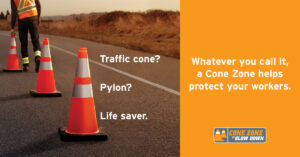
Cone Zone campaign pushes roadside safety
By Adam Freill
Construction Health & SafetyProvince-wide safety campaign aims to remind B.C. employers about the need to implement revised rules for work zone safety.
British Columbia’s 13th annual Cone Zone campaign is underway. The effort is aimed at reducing risks for roadside employees. Employers in the province are responsible for the safety of employees working at the side of the road, and are required to meet traffic control regulations, including revisions that came into effect in late 2021.
“No matter how much experience your employees have, working around traffic is dangerous,” stated Trace Acres, program director for Road Safety at Work and spokesperson for the campaign. “Employers have a legal responsibility to ensure the health and safety of their workers and contractors along B.C.’s roads and highways.”
WorkSafeBC statistics show that 12 roadside workers were hit by a vehicle and killed in B.C. between 2012 and 2021. Another 221 were injured seriously enough to have to miss work.
Health and safety laws apply regardless of how much time workers are on the roadside, with regulations governing hundreds of activities, from landscaping to utility work to road construction and maintenance.
The Cone Zone campaign is a provincial initiative supported by the Work Zone Safety Alliance and managed by Road Safety at Work. In addition to the annual launch, timed to align with the spring and summer increase of roadside work, the organizations also launched a new website for the campaign, www.ConeZoneBC.com.
“With the summer road work season ramping up, I thank the employers who are making sure safety protocols are up to speed to keep their workers safe during this busy time on our highways,” stated Rob Fleming, Minister of Transportation and Infrastructure. “The Cone Zone campaign serves as a reminder to employers and drivers about the risks associated with road work zones and the importance of following Cone Zone guidelines.”
WorkSafeBC’s Occupational Health and Safety Regulation’s Part 18: Traffic Control was revised in December 2021. The changes include new requirements for supervision and use and positioning of traffic control persons (TCPs). For example, using TCPs when speed limits are greater than 70 km/h is prohibited.
Safety best practices can include the use of detours to keep traffic away, using concrete barriers to isolate workers, making use of automated flagger devices, and using traffic control persons, but only as a last resort.
“Each roadside work zone has its own unique set of hazards associated with roads, traffic, vehicles, weather and work activities,” Acres explained.
Any employee who works at the side of a road for any reason and for any amount of time counts as a roadside worker. A driver who pulls over to the side of the road to secure a load, for example, is a roadside worker while they’re doing that job, advises the safety organization.





